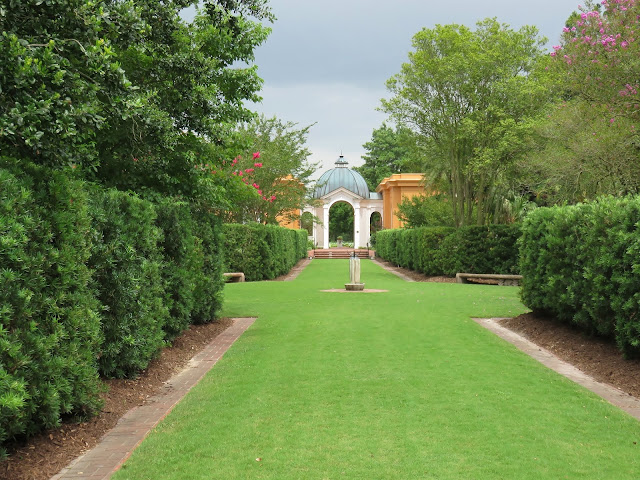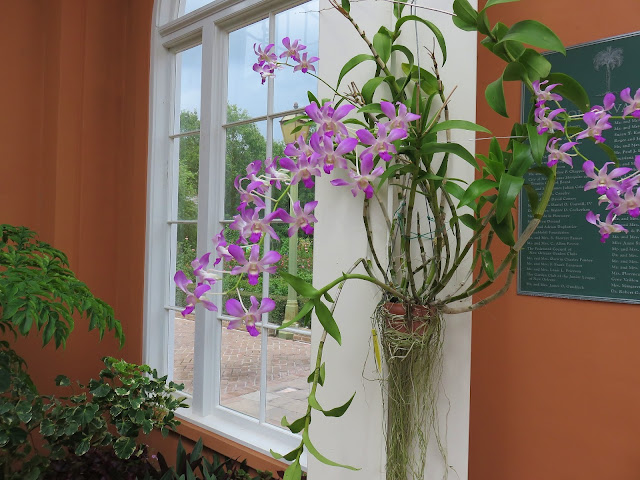Riverfront Park in Memphis
The motivation for this trip to the south was family driven. A 50th wedding anniversary in California and a wedding in New Orleans six days later called for a trip with some exploring in between. Tom said he wanted to see the Mississippi Delta for himself, to see if it was like it has been portrayed in books and movies. Tom is a geography major. We both like history. We both enjoy agriculture, seeing what people grow and how they grow it. And of course, wherever we go, we want to know about the indigenous plants. We also like to "collect" state capitols, to visit the buildings that are the seats of government in each state, and pick up a bit of history along the way.
It was for these reasons that we chose our itinerary: Fly to San Jose for the anniversary reception, and then on to Memphis to begin our road trip down the Mississippi River. For us, travel is about learning as much as it is for pleasure. So what did we learn?
Fields of soybeans and wood lots
1. Tennessee is beautiful, so green and verdant, with hardwood forests inland and vast agricultural fields on the floodplain of the river.
Shop window on Beale street, Memphis
2. You can visit Memphis for a half day and not go to Graceland, but you can not escape Elvis.
On the levee at Greenville, MS
3. From Memphis to New Orleans, the river is wide and the levees are high. You can walk, and sometimes drive, on the levees. 4. I always think of Mississippi as a poor state. I shouldn't. The part we saw was beautiful, so green and well tended. We drove the Blues Highway, Hwy 61, and the Great River Road, Hwy 1, passing green fields and green woodlots and small towns with white steepled brick churches, with Black-eyed Susans along the roadsides, and never any litter.
Miles and miles of corn fields
5. It was clear that small towns had fallen on hard times, with shuttered stores and almost no new construction. But the farms were huge, the tractors enormous, and all fitted with chemical sprayers. There were also crop dusters working. Agribusiness depends on chemicals.
6. It appears there is no cotton to be found in Mississippi. Where cotton used to be king, now almost every field is planted in corn or soybeans, just as we saw in our recent trips to New York and Pennsylvania and Ohio. We did see one rice field.
7. Mississippi is lovely unless you are poor. Farm workers homes were often small and old, wood construction or older mobile homes with one air condition unit in one window.

Shrimp and grits - yum.
8. You learn to slow down in the south in the summer. The air is heavy with humidity and heat. We saw very few people out and about. It would be easy to put on pounds living here. It's too hot to exercise and the food is often heavy and fried.
Vicksburg National Historical Park
State capitol in Jackson, MS
Melrose Plantation in Natchez, MS
Cotton was the basis of wealth for the plantation owners and the bankers and the tradesmen and the businessmen. Wealth was tied up in property and slaves. It was easy to see why white property owners chose to look at black slaves as sub-humans. It made it possible to own them as work animals so that they could sustain their way of life. Ending slavery meant ending that flow of wealth. That and the destruction of so many lives and so much infrastructure during the Civil War caused hard times and long lasting bitterness. There was much to overcome. 10. The Louisiana State Capitol in Baton Rouge is a monumental building, with a central tower 40 stories tall. It is, in fact, a monument to Gov. and Sen. Huey Long, who commissioned its construction as a public works project during the great depression. He said he wanted it to be the tallest capitol in the land. It is. It was also the place where he was assassinated.
11. This trip was all about the river, the Mississippi. We learned that in Vicksburg, scene of Civil War battles and the siege that ended in the Union controlling the river, the river eventually changed course and left Vicksburg with only a man made channel.
South of New Orleans, we drove out into the delta an hour's distance, where the river was still confined between levees and a steady flow of ships steamed in and out of the docks of refineries and chemical plants and grain elevators. Commerce is huge on the river.
A container ship coming up river in New Orleans, as seen from the Riverwalk.
The levee way out in the delta where the Katrina storm surge covered everything.
We live in a vast and varied country. Given that, it's quite amazing that we get along as well as we do. For the most part we are all good people who want the best for ourselves and our families and our neighbors.





















































































